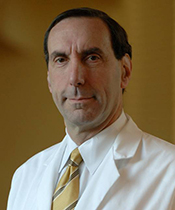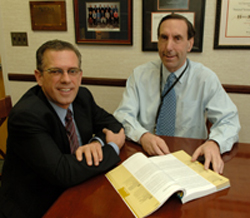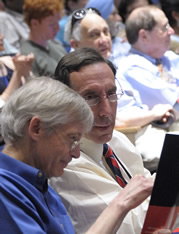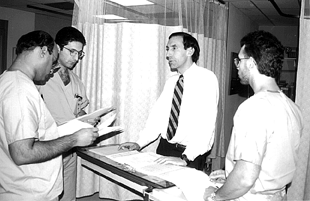Back to 60th Anniversary Reflections.
Dr. Henry Masur recounts childhood memories of center's beginning, his path to medical research

Since 1989, Dr. Henry Masur has been chief of the Critical Care Medicine Department at the NIH Clinical Center. Under his leadership, the department has attained national and international acclaim for its leadership in the areas of sepsis, emerging infections, HIV/AIDS, lung biology, and sickle cell disease and has developed a highly competitive training program in critical care medicine. Dr. Masur is well known for his expertise in HIV-related opportunistic infections. He leads the District of Columbia Partnership for AIDS Progress, a unique collaboration between NIH and the DC government that aims to create an urban model for decreasing the impact of HIV/AIDS on underserved populations. He has been president of the Infectious Disease Society of America, chair of the FDA Antiviral Advisory Committee and is the founding chair of the first NIH guideline related to HIV/AIDS on management of HIV/AIDS-related opportunistic infection. On Dec. 23, 2013, he shared his reflections on the history of the Clinical Center in an interview conducted by Janet Hulstrand, from the Clinical Center Office of Communications and Media Relations, in his office.
I thought you'd be an interesting person to talk to in regards to the history of the Clinical Center because your father was the first director, so I think you have a really rare insider perspective. And one of the first questions I wanted to ask you was when you first became aware of a place called the Clinical Center, and what are some of your first memories about it.
Well certainly my father was very impassioned about the development of the hospital here, and about recruiting people to NIH, so that NIH was a regular topic of conversation even among the family: the people he was recruiting, the building, the renovations of the building ... He often entertained people who were either interviewing for jobs or who were on the staff. James Shannon, Robert Marston, Donald Frederickson, Joseph Smadel, Kenneth Endicott and Leonard Scheele all appeared at the house from time to time. Of course, I had no idea who they were! There was a tremendous amount of enthusiasm for the mission of the organization, for the science they were doing, for the patients they were bringing in, for the patients they had saved from one problem or another.

I remember really interesting construction projects that my father would show friends and family as the Clinical Center was built. One of the things that my father was very firm about was that the Clinical Center was supposed to have the best nurses, the best social workers, the best dieticians, the best food for the patients; it was supposed to have the best ambulances to take the patients to and from the hospital; they were supposed to have the best of everything for these individuals who were volunteering for research studies. So the mindset of the group of people he worked with was really, they wanted everything here to be the best in the world, so that people would come here and say that the science, the patient care, the facility, everything set the standard for the world.
This was a group of people who were extremely enthusiastic about being in the Public Health Service and being part of a federal organization that was novel. They had visions of an NIH that would grow in global impact, creating an infrastructure for unprecedented accomplishments intramurally and extramurally. And, we can see that generations of NIH leaders have achieved that vision!
How old were you? You were pretty young...
When the hospital opened, I guess I was five. So my recollection really is not very much of the science, but of coming up to visit the construction or coming up to see the animal facility. It was always a great opportunity to come and see the monkeys. The famous people I met had little impact on me unless they took a special interest in children! Some I remember with great fondness because they were interested in baseball, or electric trains, or ham radios, or they had interesting gadgets in their offices, or their pockets. That's what I remember about that generation, rather than what really made them famous.
To go back to something you just said about the novelty of this endeavor. Can you talk a little bit about that? About how and why what was happening here was so new?
I can give you my perspective now. Back then, I didn't really have any perspective except that clearly, when the hospital was built and when it was expanding and they were bringing new people in, they were always talking and plotting about how to recruit and how to bring various people to the Clinical Center. And it was really that sense of enthusiasm, that they thought it was novel rather than that, at that age, my having any insight about why it was novel or how it was different.
Your father was the first director and then the fourth also. Do you remember anything about that process, maybe about what he talked about in coming back to it?
My father came to NIH from New York City, where he had risen as a hospital director and developed experience building and opening facilities for Montefiore Hospital, and then for the Federation of Jewish Philanthropies. He was recruited here to oversee the construction and development of NIH's first hospital. He stayed in that position for three years and then was recruited to a leadership position in the Public Health Service as the director of Division of Hospital Services, and at that point, they had 90-plus facilities around the country that were everything from quarantine stations for immigrants, to the leprosarium, to the drug abuse center in Kentucky. I remember well the number of facilities in the system because he used to have a U.S. map in his office with magnets marking each facility, and my sisters and I would always move them around, which amused his office staff—I think! He was also very involved in the Hill Burton program, building hospital facilities around the country.
I don't know what his career intent was at that point. But I do know that in 1957, when the first polio vaccine was released by the FDA, there were some inadequately inactivated vaccines distributed by a commercial manufacturer that led to children developing polio because of those inadequately inactivated vaccines. Even though he had nothing to do with that—he was I think at that point the third-ranking person in the Public Health Service—President Eisenhower removed the Surgeon General, the Deputy Surgeon General, and my father from their jobs. I suppose he had to make some bold gesture. My father was then given an opportunity to come back to NIH, so he came back as the Director of the Clinical Center. At that point he was also very active in the American Hospital Association. He became the first federal employee to be president of the Association, and this became an opportunity for him to speak nationally and internationally about academic research and the role of the federal government.
I came across a quote by him, I guess it was something he frequently said, that, "At the Clinical Center we don't follow standards, we set them," something like that
I've heard that said before. That would certainly have been his mindset. I would hope that we continue to follow that approach!
How much did your father's career have an influence on yours? Were you inspired to go into medicine because of him, or because of the exposure you had to this place? How did it come to be that you wanted to be a doctor?
I suspect that career decisions for most people are a complex process. I was very impressed by how enthusiastic he and his friends were about their jobs: they felt they were doing something worthwhile for the public good. It's really that enthusiasm that he and his friends had for medicine, for science, their enthusiasm for the kinds of people they met—they all had lots of friends that they were often in contact with—so it was really that enthusiasm that I think I picked up on. He was, I think, always very cautious about pushing any of his children into a career—he didn't want to inflict a career on anybody, so he was fairly subtle about what he had to say. When I ultimately decided to go into medicine, I think he was pleased. I of course was disappointed that he did not live long enough to see me graduate from medical school, and that he was not able to advise me and witness the path that I took, ultimately landing at the institution he was so dedicated to.
So you weren't pressured at all...
No, he was a great tactician, and his strategy was not to be overt about what he wanted me to do. However, it was very easy to read his body language. He didn't have to say anything. I could tell what he was hoping.
So you knew clearly when you chose to go into medicine that he was pleased...
I was always aware that that was his unstated goal.
And you've been happy with it...
I have, yes.
When did you decide to go into medicine?
In college, I decided that I would do the pre-medical curriculum while majoring in history, but I really wasn't absolutely certain that medicine was what I was going to do until, like many people, when it was time to graduate and I decided that I had to make a decision. It was really then that I decided I would apply to medical school. So medicine was always a strong consideration, but I don't think I really decided until my senior year in college.
So it wasn't something you decided at a very early age and then just followed through...
No. I was not one of these people who knows from an early age that they're going to be a scientist of some sort.
Can you talk a little bit about the path that brought you from medical school to be here?
I never had a conscious intention to come to the NIH to work. I was eager to develop my own career. I wanted to make sure that I was taken seriously for the contributions that I could make rather than being seen as someone who came in because his father had been at the institution. And my father actually died when I was a first-year medical student, so he didn't really have, at that point, any direct influence on my decisions about internship, fellowship, or my earliest faculty appointments.
It was really a series of serendipitous events that led me to come to NIH. I decided I wanted to train in infectious disease, because I had met some people at Cornell who were very charismatic, and infectious diseases seemed interesting, there were a lot of exotic diseases, and there were a lot of new drugs and vaccines coming along that were likely to change medical practice and public health. I joined a parasitology laboratory at Cornell where most of the major parasites were being studied. The laboratory director assigned me a relatively obscure parasite, Pneumocystis carinii. After doing some basic parasite immunology in the laboratory, I was sent to Brazil for a year to participate in a field trial, studying leishmaniasis, and to find cases of pneumocystosis.
When I came back from Brazil, having seen no pneumocystis down there, I happened to be in New York when a patient came into the emergency room with pneumocystis pneumonia. This patient turned out to be one of the first patients with the disease now known as AIDS. I studied this patient intensively and found other patients at other hospitals with similar syndromes. I saw that something new was happening, although at that time it was far from clear that this new syndrome would be something other than a rare disease due to some local, as yet unexplained, phenomenon. I submitted a manuscript to the New England Journal of Medicine, leading to some not-so-subtle inquiries as to who were these young investigators, and did they really have their facts correct. Ultimately there were three articles in the New England Journal of Medicine in 1981, and one of them was my first authored article.

At that point Tony Fauci was at NIH, and Tony was very interested in establishing an AIDS program. Tony was also a Cornell graduate, and I had known him well because he was the chief resident when I was a fourth-year sub-intern on the medicine wards. When he saw the article, he thought I could use my experience to inaugurate a program at NIH. In addition, he had just helped the Clinical Center recruit Joe Parrillo to revamp the Critical Care Medicine Department. Since the AIDS patients were likely to spend a lot of time in the ICU, it seemed logical to place me in the Critical Care Department, where I could help develop the ICU while I was helping to develop an AIDS program.
I came to NIH as an infectious disease specialist, to be the assistant chief of critical care, having no training in critical care, other than being a good internist. But I learned critical care on the job from Jim Shelhamer and Joe Parrillo. Cliff Lane had just arrived as a fellow. Cliff and I started the AIDS program under Tony's direction, with a staff of two (just the two of us). But quickly many clinicians and scientists volunteered to work with the program. We would have weekly meetings with scientists from a wide variety of institutes and labs, planning our studies and discussing patient care.
I had had some misgivings about coming to NIH. I wanted to be sure I was evaluated on my own merits and not as a legacy hire, but it seemed like NIH was a grand opportunity; and in fact 30 years later, I still think it was a great opportunity, and it still is a good opportunity, because of all the things you can do at NIH to build programs.
That leads into one of the other questions I wanted to ask you about. What is the best thing about working here, and what are some of the challenges also?
The best thing about working at NIH is that it's a science-based organization where good ideas usually carry the day. So if you have a good idea, you don't automatically get support and funding, but getting approval to launch new ideas and new programs is easier than almost anywhere else. It's also important to recognize that funding here is prospective so that rather than writing up a proposal, sending it out and then having to wait for funding, you can start a project if your colleagues and supervisors agree that it's scientifically sound. The evaluations are retrospective—you have to justify what you did—but you can get a head start on a project without waiting for a grant. And then if you're successful, you can continue to build. There are thousands of scientists here who are eager to work with clinicians on projects, there is a real collaborative environment. So you can build programs efficiently and effectively. And for both building the critical care program and for building the AIDS program, being able to get the immunologists and the hematologists and the neurologists and the microbiologists to work on a project, and not having to focus as much on funding, allowed great strides to be made. The accomplishments of NIH intramural in HIV/AIDS and critical care over the last 30 years speak for themselves. The intramural environment allowed these programs to flourish by encouraging collaboration, collegiality, and vision.
Some of the challenges are that salaries here are lower than elsewhere, and there are restrictions on outside activities, and on travel which didn't used to exist—those are all terrible impediments for maintaining quality here. These challenges have the potential to isolate NIH staff from working with outside collaborators and organizations, and they make succession planning difficult. At the same time there are so many opportunities, there's so much talent here, that I think it was and it continues to be a terrific place to launch a career, and for the right person to stay, so that you can accomplish some long-term goals rather than simply short-term goals. I think if you look at what's happened in critical care, or in AIDS, I think we have accomplished things which, in other institutions that rise and fall based on funding, would have been, not impossible, but more difficult, to have the same kind of sustained impact.
Looking back— what year did you come here?
1982.
So that's 31 years...you've been here half of the history of the CC, basically. What has changed in that time?

There was an era when the Clinical Center was one of the few places where you could really do cutting-edge research, where there was such wonderful laboratory support so that if you wanted to do research, most people who were ultimately successful in their careers had to come to NIH because this was the major place to launch careers. One of the things that's changed over 30 years is that NIH is no longer the only place that you can go for training, and for sustaining a career in investigation. The extramural funding that NIH provides has led to wonderful centers all over the country, so that there are many places you can launch a career. Young scientists and investigators can go other places rather than here. The Clinical Center and intramural NIH now must work much harder to demonstrate to younger investigators that the resources and environment here really are special and can accelerate careers. The competition for the best and brightest has accelerated, even in an era of limited funding. We need to continue to look for ways to compete successfully for top talent.
Thinking about the public, and what they know or don't know about the work that goes on here, specifically at the Clinical Center, but also generally at NIH: if there were one message that you could get out to people about the work that goes on here, what would it be?
The NIH is the best example of how the federal government can have a positive impact on citizens of the United States and the world. Look at what NIH has accomplished in terms of basic science, and in terms of translating science into benefits for human health. If you look at infectious diseases, if you look at cancer, if you look at heart disease, we have accomplished a tremendous amount for the tax dollars that the government has invested in this institution. So I hope people would realize that this is the kind of enterprise that really does perform a valuable service for the public, and specifically, that it does in fact promote the health of the nation. The research at NIH helps children and adults, those with common diseases and rare diseases. It really enhances everyone's health. I hope that people realize that what goes on all over this campus is the result of good stewardship of the taxpayers' dollars: NIH staff are tremendously committed, work tremendously hard, and produce results which are measurable, tangible, and that benefit the health of people nationally and worldwide.
